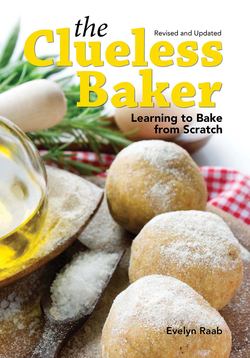Читать книгу The Clueless Baker - Evelyn Raab - Страница 11
ОглавлениеThe Basics About Some Basics
What kind of sugar, exactly? How big an egg? How much salt? Here are a few additional details you may need to know before you begin baking.
Eggs
Whenever eggs appear in a recipe, we mean standard large eggs. White or brown or blue — shell color doesn’t affect the taste, so just choose whatever best matches your décor. Freshness counts — a fresh egg will separate more easily, and beat up fluffier.
If small or medium eggs are on sale, you can use them instead of large eggs: one large egg measures about ¼ cup (60 ml). Crack your small or medium eggs into a measuring cup so you can tell how many eggs you’ll need to use in your recipe. For a recipe that calls for 2 eggs, you’ll need to use a total of ½ cup (125 ml) liquid egg.
Butter
We love butter. Because it tastes wonderful. Because it bakes beautifully. And because it’s a natural product. Unsalted butter is preferred for baking since it allows you to control the amount of salt in the finished product. If, for any reason, you wish to avoid butter, you can substitute margarine for butter in most recipes. The results will be similar, but the flavor may be slightly different.
Margarine
Look for margarine that is trans-fat free and buy the best quality that you can afford. If you prefer to avoid dairy ingredients, be sure to read the label carefully: milk ingredients in food products may be hidden in the ingredient list — look for lactase, casein, whey and milk solids, which are all secret code words for milk. If you see the word pareve on the label, you can be sure the product contains no milk or other animal ingredients.
Sugar
When a recipe calls for granulated sugar, that means ordinary white sugar. Comes in bags or cartons. The usual stuff. If a recipe requires brown sugar, you can use either light or dark brown sugar. Dark brown contains more molasses and has a stronger flavor; light brown (or golden brown) is milder but still flavorful — use whichever one you like. You may occasionally come across a recipe that calls for caster sugar. This is a finely granulated sugar often used in British recipes. You can substitute “instant dissolving” or “fruit sugar” for caster sugar, or just use regular granulated sugar — it’ll work out fine either way.
Salt
Oddly enough, a pinch of salt can bring out the sweetness in a sweet recipe. Other than that, it has no scientific purpose when you’re baking cookies or cakes, so add it if you want or leave it out. In savory (nonsweet) recipes — bread or focaccia, for example — salt really does enhance the flavor, and I recommend that you use it when called for in the ingredient list, although you can adjust the amount of salt to suit your taste.
Whipping cream or heavy cream
We’re talking cream with a butterfat content of about 35 percent. The luscious stuff that whips into fluffy clouds of deliciousness. If you’re not planning to whip the cream, however, you can usually substitute a lower fat cream (10, 15 or 18 percent), if you prefer.
